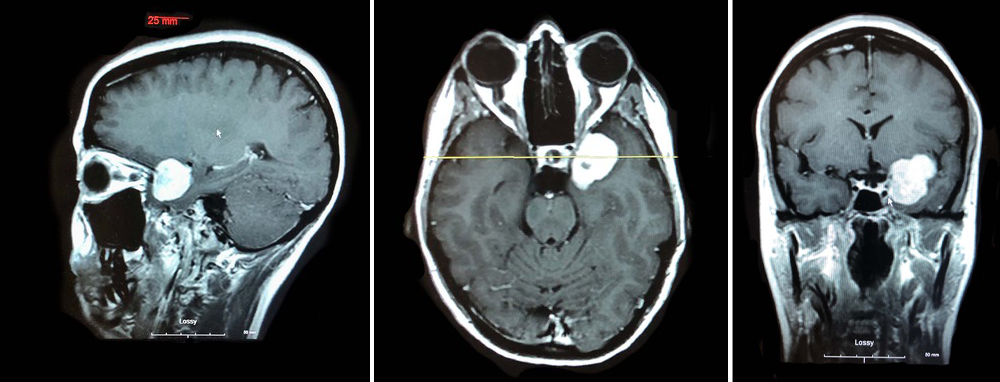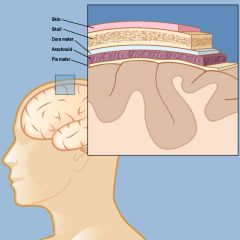
After a long day working at an outdoor assignment in summer, the photographer thought she was having a reaction to the heat. “I had two photo shoots scheduled for that day,” says Brittany of the first time she felt the terrible pain in her head. “It was 85 degrees, I was likely dehydrated, and I became so dizzy that I couldn’t drive myself home.” Brittany didn’t know it at the time, but she was about to start a long journey — one that would take her many miles downstate to New York City, and to Dr. Philip Stieg.
Brittany is a 38-year-old communications director for an arts company in upstate New York, but she also enjoys tending to her garden and working as a freelance photographer. She had never had serious headaches before, so she wasn’t terribly concerned at first.
“I took ibuprofen and Tylenol to get through the day,” she recalls. “When I got home, I laid down for 12 straight hours. The pain had subsided by the time I awoke, but I headed to the ER. I figured if it came back they could at least give me fluids. Based on my research, I thought I was having cluster headaches.” After a CT scan, Brittany got some devastating news: There was a meningioma on the left side of her brain.

A meningioma forms in the meninges, which consist of the dura mater, the arachnoid membrane, and the pia mater, which lie directly below the skin and skull.
A meningioma is a type of tumor that develops in the meninges, the protective layer around the brain and spinal cord. It doesn’t always cause symptoms, but when one does, it’s because it’s located in an area that has become affected by its growth. In Brittany’s case, it was resting on her carotid artery and optic nerve.
“I’d never heard of a meningioma before,” says Brittany. “And I’d never looked at an image of my brain before. So when they showed me my scans, it was surreal — the meningioma was the size of an eyeball!” As relieved as she was to have an answer to what was causing the headaches and dizziness, being told she had a brain tumor was shocking. “When I almost started crying, an ER doctor consoled me, saying it was likely benign.”
Brittany had a follow-up biopsy that confirmed the meningioma was indeed benign. But due to the meningioma’s proximity to the optic nerve, the potential for seizures, and Brittany’s ongoing vertigo, the neurologists at her local hospital recommended surgery to remove it. “I spoke to my uncle, who is a doctor in Los Angeles. He recommended I see Dr. Philip Stieg down in New York City.”
Brittany made the drive to NewYork-Presbyterian/Weill Cornell Medical Center to see Dr. Stieg. “I’d started listening to his podcast in advance and recognized his voice from down the hall as he was greeting people,” she laughs. “When we sat down, the first thing he asked was, ‘What do you know about your situation?’ I was impressed by his instinct to listen before speaking on what he does or doesn’t know. He’d looked at my imaging, and he came prepared. His ability to listen and speak knowledgeably to my situation put me at ease. I felt very confident after my consultation that I’d found my doctor.”
“There’s a common fear that all brain tumors are terminal,” says Dr. Stieg. “But when we’re talking about meningiomas, ninety percent of them are benign and slow growing. Patients have three options: The first is evaluating the tumor and scheduling regular visits back to us to assess its growth. A second option, depending on size and location, is radiation, or radiosurgery if the meningioma is small enough. The third option is surgery, which is typically considered when the meningioma starts affecting the patient’s quality of life and it can’t be treated any other way.” Due to the pain, which was interfering with Brittany’s day-to-day life, Dr. Stieg agreed that the tumor should come out.
“Because of the location of the meningioma, we planned a craniotomy to open the skull and access the meninges,” says Dr. Stieg. “Then we’d perform a resection — a complete, careful removal of the tumor without damaging healthy brain tissue.”
Dr. Stieg’s team kept in constant touch with Brittany. “They kept me well-informed throughout,” recalls Brittany. “Dr. Stieg’s nurse practitioner, Sophia, was always available for questions and walked me through every step of the way. Darcelle helped me schedule everything, and Destinie handled the insurance, among other things. The team helped me plan, because there was travel involved. Everyone was so lovely to be around.” Brittany says the only thing she hadn’t anticipated was walking herself into the operating room. “They asked me to walk in and climb onto the narrow table. Before I knew it, they put the mask on me for the anesthesia. And I was out.”
Brittany woke up in the recovery room with some head pain, and she instinctively used sign language — which she uses with her non-verbal daughter — to let the doctors know. Her motions were puzzling at first.
“The surgery had gone as planned,” recalls Dr. Stieg, “so we weren’t sure what she was doing until one of our residents said, ‘She’s signing, “It hurts.”’ Of all the surgeries I’ve done, that was one of the more surprising things I’d experienced!”
“I hope I didn’t scare them too much,” laughs Brittany. “I remember they asked me if I wanted to manage the pain with morphine and I signed ‘Yes.’”
Brittany was discharged from the hospital three days after the surgery, and she returned home to continue her recovery with occupational and physical therapy. “I still had double vision with both eyes open,” she says, “but the therapist encouraged me to keep them open to help regain their strength. I worked with my physical therapist to regain my balance. At the start, I could only stand on one foot for 15 seconds. When I graduated from PT, I was back in range with my age group. I was concerned that I experienced double vision for three months, which was longer than I had anticipated — and a little nerve-racking — but all my doctors said I just needed time. They were right!”
Today, Brittany is back at work and back to scheduling photo shoots in her free time. “Before the surgery, my life was a battle against intermittent headaches, positional vertigo, and general dizziness,” she says. “Since the surgery, I haven’t had any of that. You wouldn’t even know I had surgery if I wasn’t still regrowing my hair. I remember Dr. Stieg said something about that to me at our consultation: ‘This is a speed bump in your life. This is your run-of-the-mill meningioma. It’ll be removed, you’ll move on with your life, and that’s all it’ll be.’”
There’s one experience that still sticks with Brittany. “When I came back to get my staples removed, my friend accompanied me. I was telling her about how helpful one of the team members, Destinie, had been. Destinie actually stopped in to visit me, and my friend was in awe of how she knew my story and made it a point to say hi. I had such a great experience at Weill Cornell. And I’m just so thankful to the team and my many friends and family members who helped and supported me and my family throughout this process. I am so lucky.”